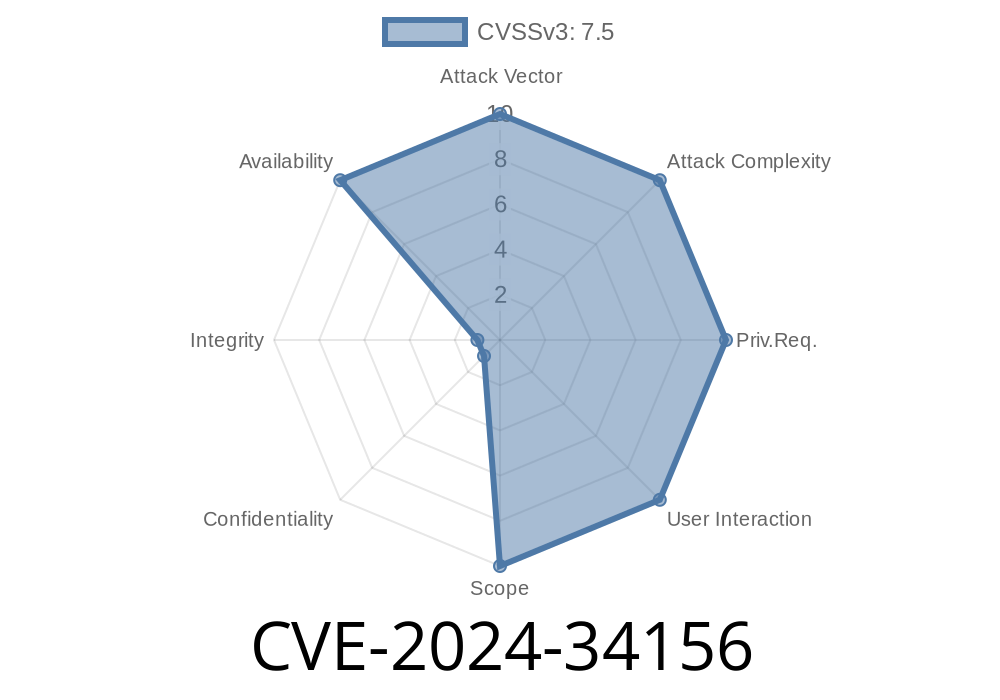In this post, we'll be discussing a newly discovered vulnerability in the GoLang programming language's Decoder.Decode function (CVE-2024-34156) that has the potential to cause a panic due to stack exhaustion in the presence of deeply nested structures. This is a follow-up to a previous vulnerability (CVE-2022-30635) that was identified and addressed earlier. We will cover the details of the vulnerability, code snippets demonstrating the issue, and references to the original research.
Vulnerability Details
The vulnerability arises when the Decoder.Decode function is called on a message containing deeply nested structures. The GoLang runtime is not designed to handle unbounded recursion which can ultimately lead to a stack overflow error and a panic. An attacker could send a specifically crafted payload to exploit this vulnerability and cause a denial of service (DoS) or even potentially execute arbitrary code in some cases.
This vulnerability is related to CVE-2022-30635, where a similar issue was reported and fixed. However, the fix for CVE-2022-30635 was insufficient, and the issue persisted in certain situations, leading to the discovery of CVE-2024-34156.
Consider the following GoLang code snippet that demonstrates the issue
package main
import (
"bytes"
"encoding/gob"
"log"
)
type Nested struct {
Value int
Child *Nested
}
func main() {
var data []byte
gob.Register(Nested{})
for i := ; i < 10000; i++ {
nested := Nested{
Value: i,
Child: nil,
}
buf := &bytes.Buffer{}
enc := gob.NewEncoder(buf)
err := enc.Encode(nested)
if err != nil {
log.Fatalf("Error encoding nested structure: %v", err)
}
data = append(data, buf.Bytes()...)
}
buf := bytes.NewBuffer(data)
dec := gob.NewDecoder(buf)
for {
var nested Nested
err := dec.Decode(&nested)
if err != nil {
log.Fatalf("Error decoding nested structure: %v", err)
}
}
}
In the above code, we create a nested structure using a loop and encode it using the gob package. Then, we try to decode the nested structure using the gob.NewDecoder function. The issue arises when the depth of the nested structure exceeds the maximum allowed by the Go runtime, leading to a stack overflow error and a panic.
Exploit Details
An attacker can exploit this vulnerability by crafting a payload with a series of deeply nested structures that, when deserialized, would result in a stack overflow error and a panic in the target application. This could lead to a denial of service and possibly arbitrary code execution in some cases.
It should be noted that this vulnerability depends on the specific implementation and usage of Go's gob package in the target application. As such, it may not be applicable to every GoLang application.
Mitigation
As of the release of Go 1.18, there are no direct mitigations for this issue within the Go language. Developers are encouraged to cautiously implement decoding logic and limit the depth of recursion allowed in their applications. It is essential to validate and sanitize user input, especially for data that will eventually be deserialized.
Conclusion
CVE-2024-34156 is a serious vulnerability in the Decoder.Decode function of GoLang that can result in a stack exhaustion panic due to deeply nested structures. It serves as a reminder of the importance of validating user input and the risks associated with recursion. Developers should apply best practices when using Go's gob package and exercise caution when working with user-generated data.
References
1. CVE-2024-34156
2. GoLang's Gob Package
3. CVE-2022-30635
Timeline
Published on: 09/06/2024 21:15:12 UTC
Last modified on: 09/09/2024 15:35:07 UTC
